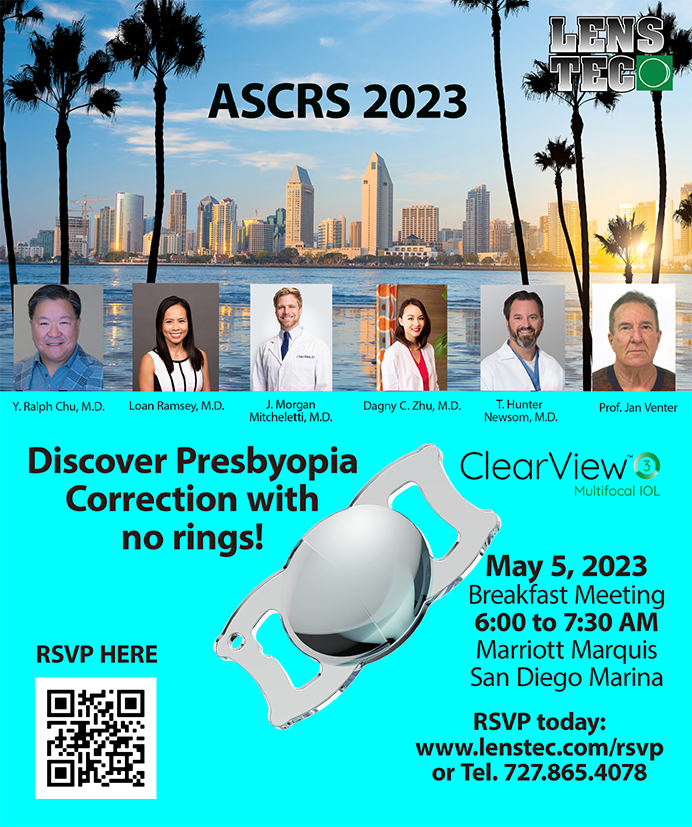
Ophthalmology continues to move into the era of comanagement. As a result, we are seeing the advent of business models that allow ophthalmologists to shift away from seeing patients in the clinic toward spending all of their time in the OR. This unique business model is working for some of our colleagues. I am often asked whether I plan on eliminating daily clinic hours in my private practice. I am confident in the skillset of the optometrists with whom I work, and I value the relationships I have developed with them. I do not, however, think this trend is possible for my style of practice.
In my experience, the success of routine and refractive cataract surgery, both of which should include fantastic surgical outcomes and high patient satisfaction, begins with the decision-making process in the examination room. The development of surgical skills throughout one’s career simplifies the execution of good surgery. The thoughtful and individualized process of identifying the best treatment options for each patient therefore continues to be one of the most challenging—and interesting—aspects of being a modern refractive surgeon. This is one of the most important (and underappreciated) skills I teach my residents and fellows.
Preoperative workups and diagnostic testing have become critical components of treatment decision-making, and they are vital to ensuring good outcomes for patients. Corneal topography and tomography, posterior segment OCT, and a thorough ocular examination are vital to determine which surgical plan is right for each patient. The preoperative examination often reveals ocular surface disease, corneal and endothelial dystrophies, epiretinal membranes, and other conditions that guide our recommendations for IOL selection and set visual outcome expectations.
Another challenge that we frequently encounter is preoperative planning for patients with a history of refractive surgery. Patients who underwent PRK, LASIK, or radial keratotomy many years ago are presenting for cataract surgery with increasing frequency. Treatment decision-making for these patients is thought-provoking and requires a complex strategy for delivering excellent outcomes and high patient satisfaction.
Other facets that are taken into consideration during the preoperative evaluation are the patient’s lifestyle, hobbies, work, frequency of contact lens or spectacle use, and feelings about being spectacle independent.
As our industry continues to provide myriad solutions such as expanding monofocal, toric, extended depth of focus, multifocal, and hybrid IOL options and offering enhanced spherical aberration optics with an extended range of vision, the decision-making process becomes even more nuanced.
Refractive cataract surgery is evolving into an almost aesthetic-like elective procedure with increasingly high patient expectations. We are under constant pressure to deliver perfect vision for our patients. There is also pressure from industry and colleagues to increase premium IOL conversions and offer options to fine-tune cataract surgery outcomes if necessary. The concept of one-size-fits-all cataract surgery is no longer viable in our technology-forward specialty.
Successful outcomes start with patients’ confidence in their surgeon and the establishment of trust between patient and surgeon. This begins in the examination room. Ensuring that patients are comfortable with their treatment decision and will receive the finest care possible is vital to developing trust and achieving postoperative satisfaction.
I believe that, with proper training, a business model in which physician extenders tackle the challenges of the decision-making process during preoperative examinations could provide excellent surgical outcomes for patients. As the landscape of technology continues to change and as more advanced diagnostic capabilities become available, thoughtful decision-making will continue to be a challenge even for surgeons. If the right decision is not made in the examination room—and if trust is not established between the surgeon and the patient—there will always be the risk of postoperative dissatisfaction.
As much as I love surgery, it is hard to imagine relinquishing the preoperative examination and treatment decision-making process in favor of performing more surgery. I believe that I would be missing out on forming a trusting relationship with my patients, and this would be detrimental to my patients and to me.




